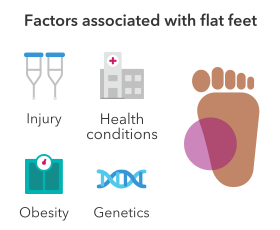What causes flat feet?
Flat feet occur when the raised structure on the inside of the foot, called the medial arch, is especially low. This is very common in children when the medial arch is still developing. By adolescence, the arch is more fully formed. In most cases, flat feet resolve on their own. But for some, the medial arch never fully develops or may collapse later in life.
Are flat feet genetic?
Scientists at 23andMe discovered that genetic variation may make some people more likely to develop flat feet than others. Studies have shown that injury, obesity, and certain health conditions may be associated with flat feet.

Did you know?
23andMe researchers have found 414 genetic markers associated with flat feet.
Ready to take the next step?
23andMe offers a Flat Feet Trait report that can give you insights into how likely you are to have flat feet based on your genetics and other factors. All you need is our Health + Ancestry kit and your spit to find out what your genes have to say about your feet and much more. No fancy footwork required.

Health + Ancestry Service
References
Lee MS et al. (2005). “Diagnosis and treatment of adult flatfoot.” J Foot Ankle Surg. 44(2):78-113.
Toullec E. (2015). “Adult flatfoot.” Orthop Traumatol Surg Res. 101(1 Suppl):S11-7.

Leave a Reply